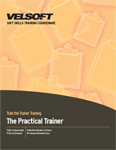Course outline for
The Practical Trainer
The Practical Trainer Course Outline

How to Use This Guide
Session One: Course Overview
Session Two: Defining a Successful Training Program
Defining Successful Training
About Audiences
Advantages of Workplace Training
Session Three: What Makes a Successful Trainer?
Key Characteristics
Mistakes and Solutions
Stimulating a Readiness to Learn
Session Four: A Word About Adult Learning
Session Five: The Learning Process
Session Six: Principles of Adult Learning
Making Connections
The Principles of Adult Learning
Making Connections
Session Seven: What’s Your Type? How About Mine?
Assessing Your Preferences
What Does it Mean To Have a Number?
The Experiential Learning Cycle
Learning Styles
Session Eight: Applying the Learning Cycle
The Four-Stage Cycle
Making Connections
Individual Exercise
Session Nine: Extroverts and Introverts
Introversion/Extroversion Survey
Case Study
Session Ten: The Training Process
Process in Brief
When is Training Necessary?
Three Steps to an Efficient Needs Analysis
Help! I Need a Template!
Session Eleven: Planning Training
Developing Objectives
Writing Objectives
Researching Content
Planning an Interactive Program
Session Twelve: Choosing Training Methods
Training Methods
Environmental Concerns
Individual Exercises
Session Thirteen: Designing a Learning Sequence
The Model
Sample Sequences
Session Fourteen: Adding Games
The Value of Games
Types of Games
Session Fifteen: Setting the Climate
Session Sixteen: Presentation Skills
Telling vs. Showing
The Delivery
Tips for Stunning Visuals
Types of Visual Aids
Session Seventeen: Dealing with Difficult Trainees
Session Eighteen: On-the-Job Training
Session Nineteen: Training Presentations
Session Twenty: Designing Evaluations
Recommended Reading List
Post-Course Assessment
Pre- and Post-Assessment Answer Keys
Personal Action Plan
Download this course as a demo
Complete the form below and we'll email you an evaluation copy of this course:
Video
More Course Outlines in this Series
- Advanced Skills for the Practical Trainer
- Developing Your Training Program
- Facilitation Skills
- Survival Skills for the New Trainer
- The Practical Trainer
- Using Activities to Make Training Fun
- Making Training Stick
- Training with Visual Storytelling
- Developing a Training Needs Analysis
- Measuring Training Results
- Developing an eLearning Course
- Mastering Adult Learning Methods
- Exploring Universal Design for Learning
- Developing a Lunch and Learn Program
- Enhanced Learning Experiences with UDL
